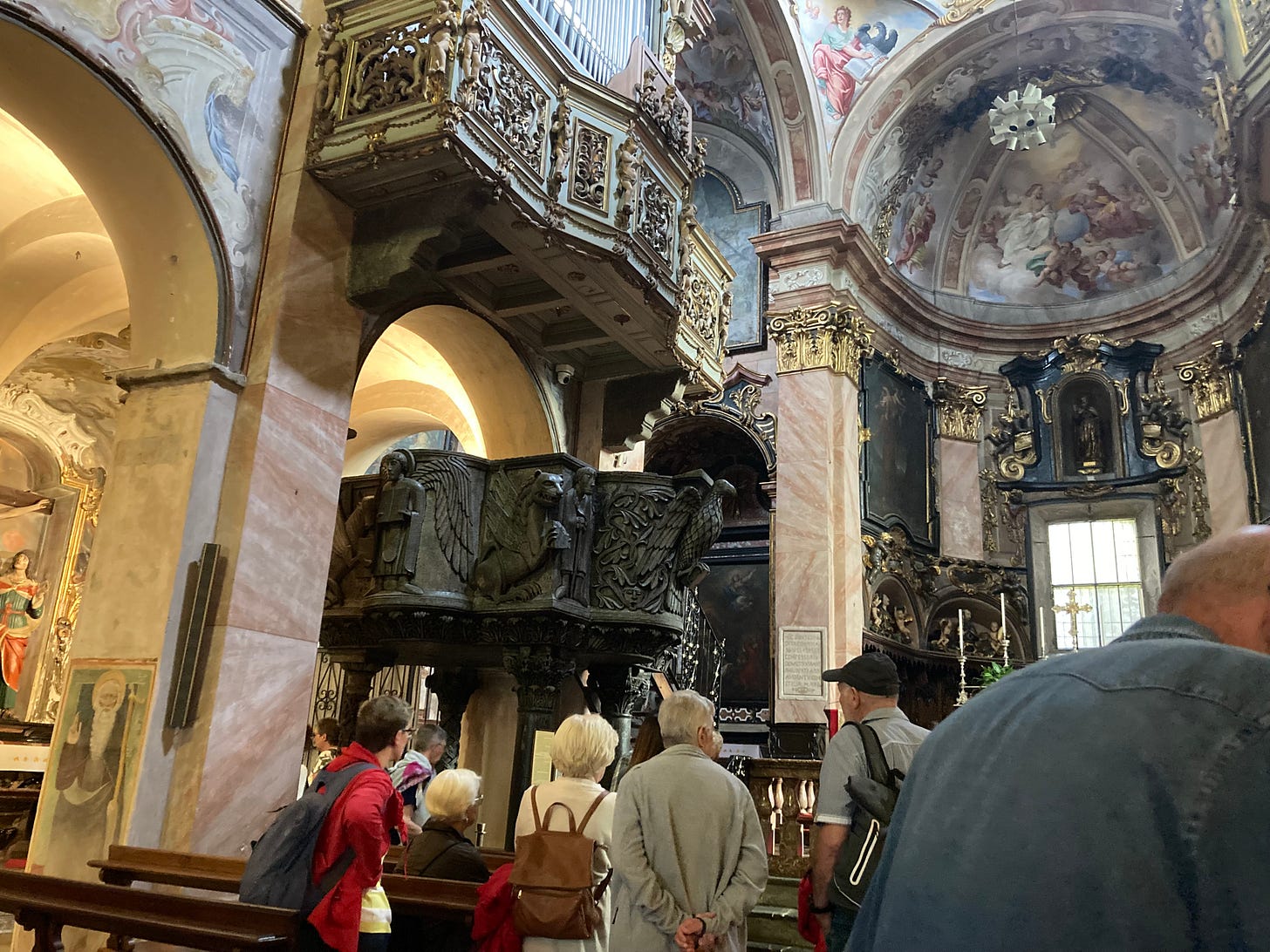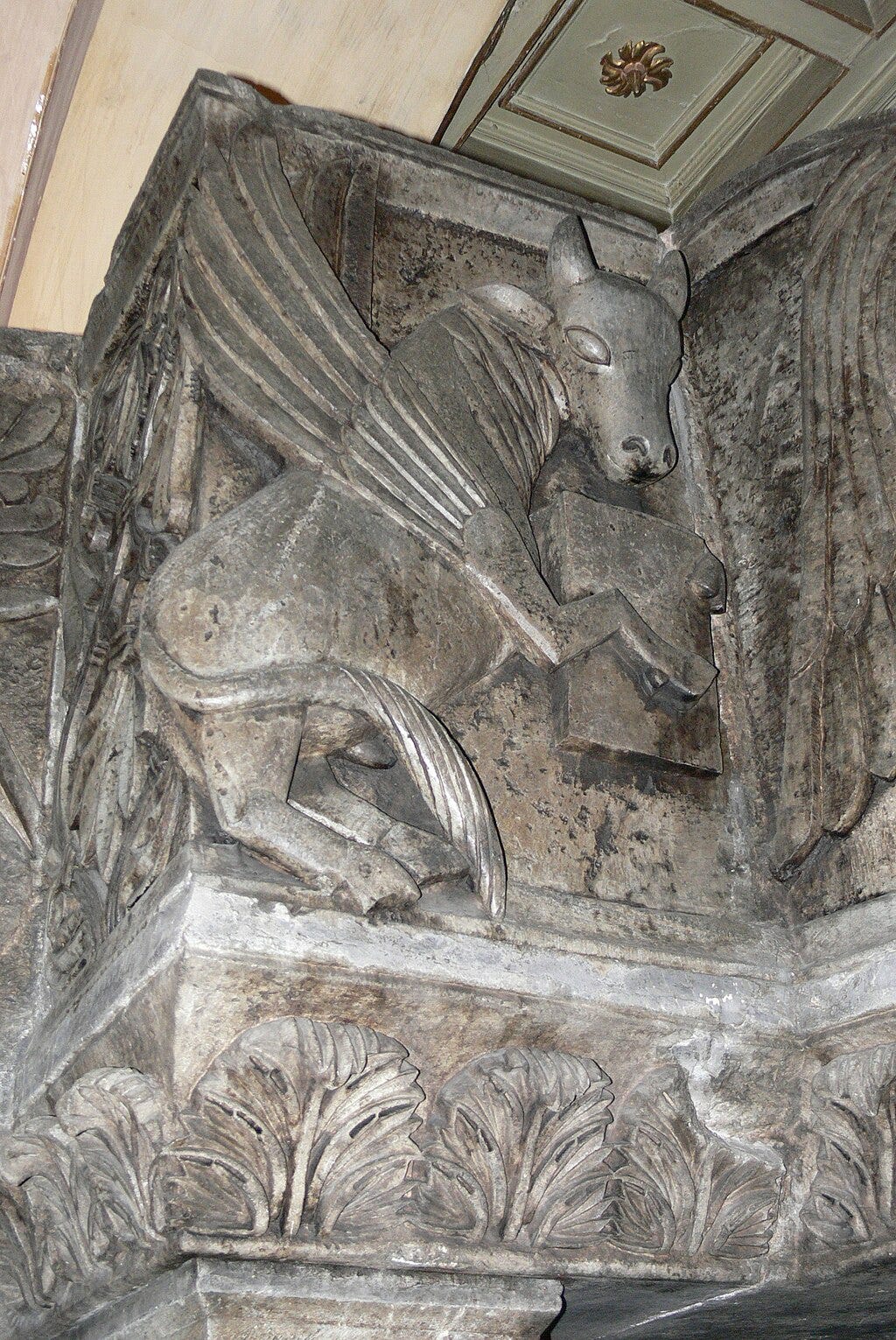Hello, hello,
Welcome and grab a coffee. Mine will be an espresso, served at a countertop and knocked back in one: I’m on the road with a wonderful group of people exploring the sights of northern Italy, from Lake Maggiore to Tuscany to the southern Alps and finishing in Venice. (If only every journey could end in Venice!)
There have been hidden gems and familiar highlights. And one, in particular caught my medievalist eye. Let me take you this week on a little boat ride to the church of San Giulio di Orta, or Saint Julius of Orta.
Small place, big history
One of the first things that is interesting about this not very big church on a really very small island in the lake of Orta in northwest Italy, is that it is a basilica, not just in the architectural sense (that I’ve written about here), but also in the legal and administrative sense. Within the Roman Catholic church, basilicas (which can be ‘major’ or ‘minor’) are ‘special’ in some way, often because they are the seats of bishops, which this one was for some time.
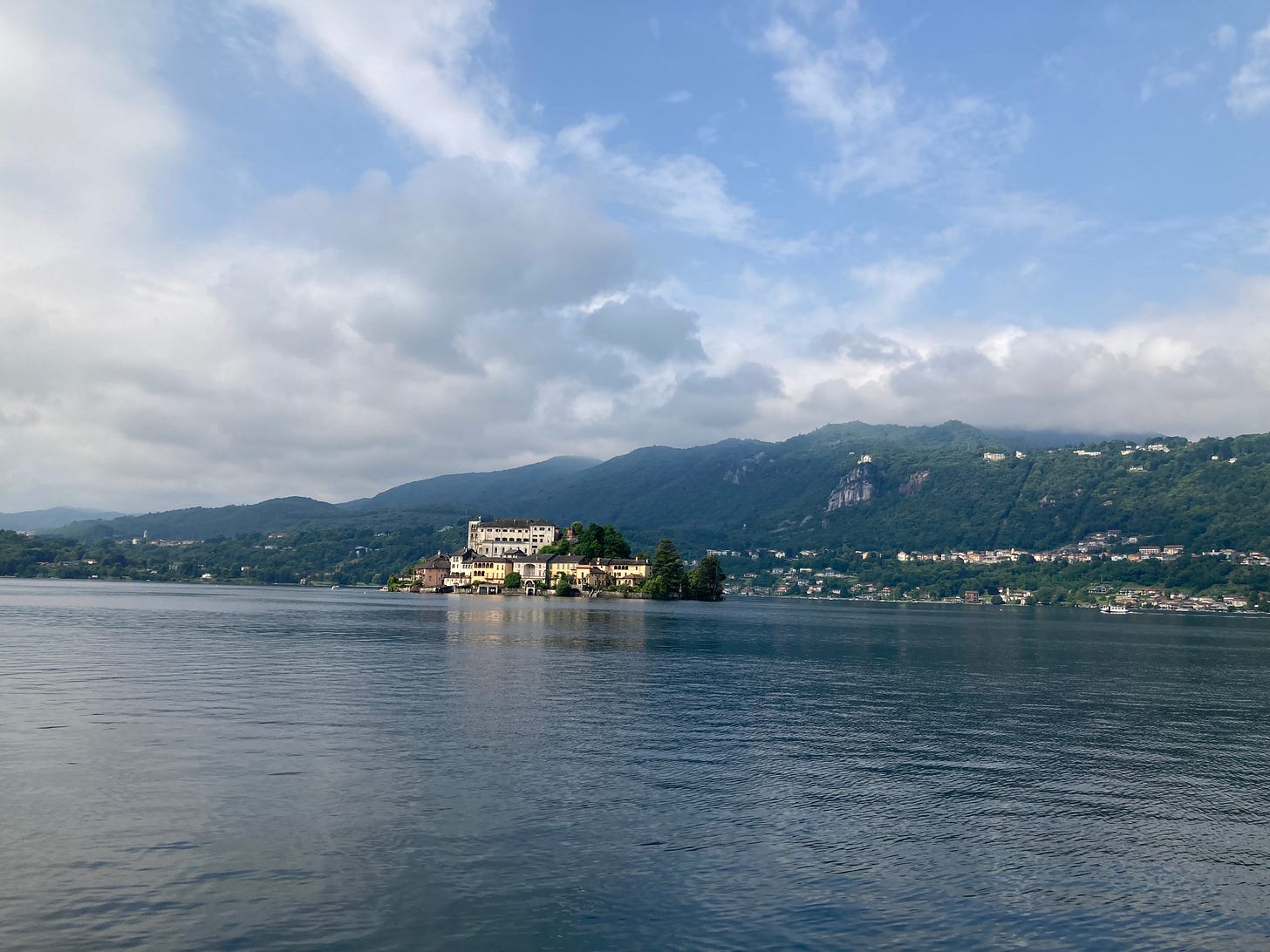
As this picture from the shoreline shows, the convent - that is the big white building in the middle - these days nearly covers the island (which is only 275m, or 900 feet, long and 140m, or 160 feet across). The basilica is partly built into the convent complex, with doors giving the nuns access to the church without having to barge past groups of tourists, which seems reasonable! Over its lifetime, though, the church has also been partially incorporated into a medieval castle, as well as being modified, added to and renovated.
The core of the building today dates from the 12th century, but sits on what archaeologists believe are the remains of a smaller 5th- or 6th-century church. Before that, the island had been settled, or at least visited, since the early Stone Age. In fact, the first church was likely put there to place a Christian stamp on a site already venerated by locals as a spiritual place (with more on that later).
It was, according to the records we have, put there to do this by Saint Julius (or San Giulio) of Novaro. He died in 401 CE, so that the earliest chuch archaeologists have located might have been built soon after, perhaps expanding or replacing an even smaller or flimsier structure he made. Giulio’s life is shrouded in a fair bit of mystery and uncertain detail, since the earliest account we have was written at least three hundred years later. He might have been Greek-speaking and have come from the region of modern Greece. He may have been sent to northern Italy to preach Christianity by the Roman emperor Theodosius I. He is said to have been abused by ‘pagans’ who didn’t want what he was preaching, but then, most saints’ stories from this period say something like that. They had to have something to be saintly in the face of, after all. Despite all the uncertainty though, current scholarly consensus is that Giulio is not a fictional character or an amalgam of several different figures.
Bits of the story might have been taken from elsewhere or a general stock of ‘things saints ought to have done’, but there probably was a man called Giulio from somewhere in the east Mediterranean who did travel to northern Italy in the late fourth century and set up a bunch of new churches and preached to people who were not then Christian. Some of them were probably not pleased to see him. And there is no reason to think that the person in the crypt of the church, displayed in a glass coffin and covered in silver, is not, in fact, that Giulio.
Today though, the church that survives shows no visible signs of that past. And in fairness, most don’t. Small buildings, often made of wood, were replaced to reflect the size and status of growing Christian communities. Decor got worn and outmoded and people wanted to display their faith and their capabilities by giving what were often the most important buildings in their community a makeover. The 12th-century church is a pretty big stone footprint over what was there before and the 16th and 19th centuries added some extra dazzle. As a result, the Basilica of San Giulio is a bit like walking into many a church in Italy with an old (usually 10th-12th-century core), that has been looked after and updated ever since.
There will be stone floors, often in colourful designs, probably some wall paintings of a couple of different periods and colour palettes, lots of golden ornamentation on columns and squinches (things that hold up domes, and this week’s ‘drop that into casual conversation if you dare’ challenge), a towering set of features on and around the altar, often like a small building insde the building, and a whole series of ceiling panels with more fresco paintings, frequently in pale blue shades. The trend was generally towards more decoration over time, so wall paintings are often older than ceiling paintings and extra decoration on existing features, like columns, obviously got put there after the feature itself.
Not every church looks like this. There are some distinct types and some distinct individual churches but it is a set of features that lots of Italian churches have and that give them, and other church interiors in Europe influenced and inspired by Italy, a distinctive flavour. And they can be hard to photograph because it is nearly impossible to get far enough back to take everything in while still being inside.
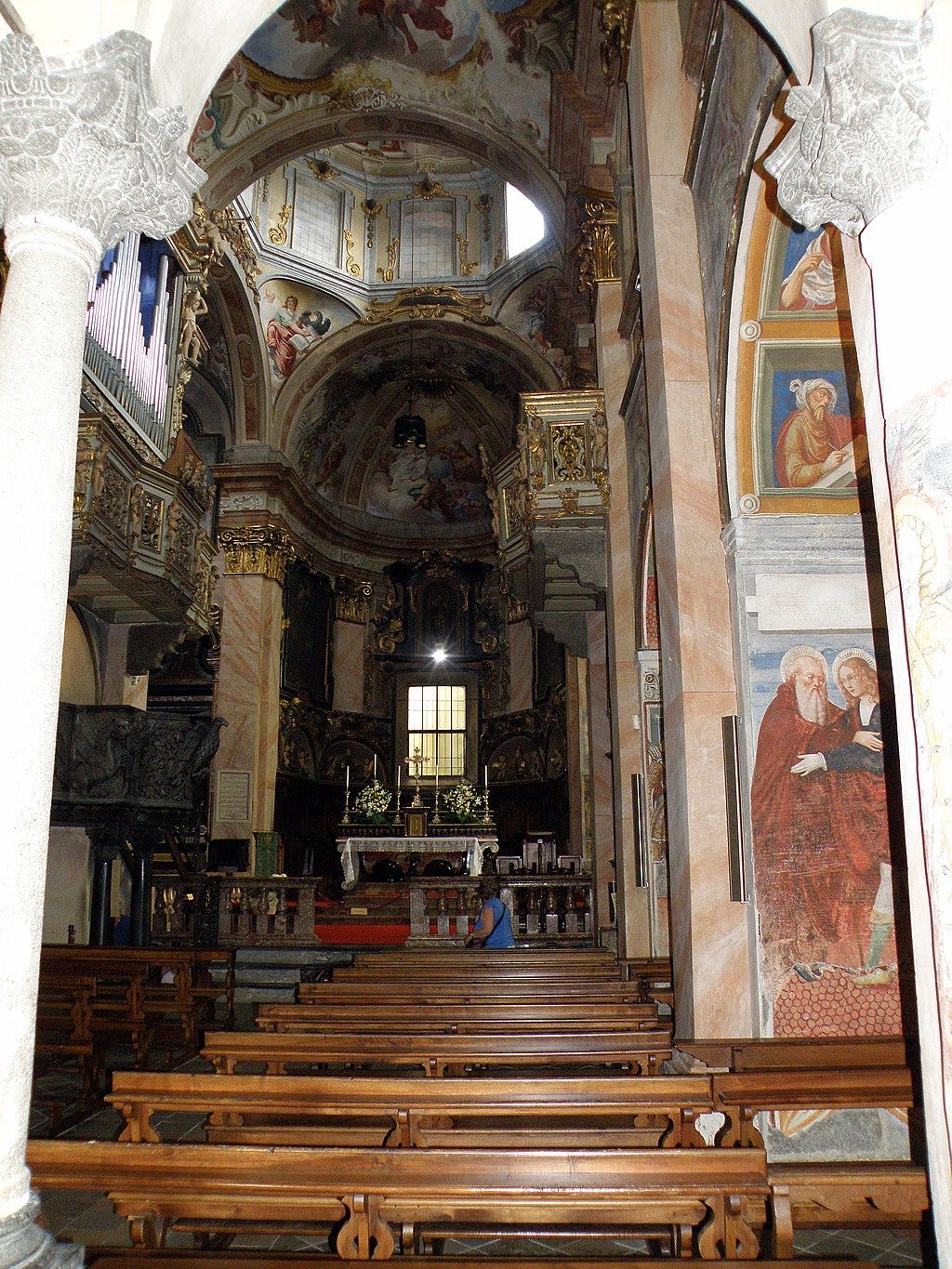
Something here is not like the other things
All churches, though, however much they may blend into one, like people in a crowd, are also unique when you start looking. There will be something, or a few things, not quite like anywhere else. For a medievalist walking into this basilica, one of them is literally right in front of you, facing the main door:

Amidst a sea of gold, the pale shades of frescos, the warm wood of worn pews and the detailed, intricate preferences of the Renaissance (a major changes in European art c. 1300-1500 are often called), the pulpit of the basilica certainly stands out. Serpentine (a hard volcanic rock) would have been a deep green when this was originally carved, but oxidation of the copper that gave it a green colour slowly turns it black. It looks heavy and plain, drawing in the light from all around it and projecting outwards in simple, animated shapes.
From this angle, we can see, from your right to left:
a griffin (a mythical creature with the head, front claws and wings of an eagle, the body of a lion and, at least here, the tail of a horse, but that could be because the artist, living in medieval northern Italy, had never seen a lion’s tail…), holding a crocodile upside down from its beak;
an eagle, holding a book in its claws and with a book resting on its back (since this was also a lectern for the speaker). An eagle holding a book in a church is always a representation of St John the Evangelist, to which I’ll return in a moment;
next along we have a man in a robe, holding a staff or a sword in front of him. To me it is clearly a sword but why people might prefer to see a staff I will also come to in a moment;
just visible peeping around the corner of this side is a lion, gripping a book in its paws. A lion holding a book in a church is always St Mark the Evangelist;
Now we have to move around 90 degrees, to the part that you can see when you’re sitting in the congrgation. It is quite hard to photograph because of an annoyingly placed pillar, but here we have, again from your right to left:
the lion, representing St Mark, more visible from this angle;
a winged man, also holding a book. This one is always St Matthew the Evangelist.
The hardest figure to picture on this pulpit is, I think, the most charming, tucked right behind that column, so here is somebody else’s (specifically, one Wolfgang Sauber’s) better picture of it:
An ox holding a bible is… you guessed it! St Luke the Evangelist.
And that gets us to the last of the three decorated sides (the fourth side is where the steps let the speaker climb up and down). With apologies for the spotlight shining in from behind:
Here we have a centaur (body of a horse, head and torso of a man) shooting an arrow at a deer who is also being set upon by wild, ravening beasts - probably wolves? But really, speciation seems to have mattered less to the artist than that they were fierce and terrible. In the background, here and on the other two sides, are leaf and vine patterns with two human faces tucked away.
Just to complete the description, there is a decorative trim of curverd acanthus leaves all around the bottom and the whole thing sits on four columns. Two (the front two as you enter the church) are plain and the other two are carved with a spiral pattern.
There is so much to love about this piece of carving. I adore the sharp pointy teeth of these vicious beasties on the back. They remind me of the pinking shears we were sometimes allowed to play with (carefully!) as children when mom got the sewing box out. That just shows, though, that I grew up a long way from the wolf habitats that would have surrounded the Isola San Giulio, when sharp pointy teeth might have conjured up more terrifying images.

With no artist’s diary or patron’s instructions to go by, decoding the symbols on this pulpit is a case of comparing what we have with known symbols from other Christian art. It has also been dated on this basis - by comparison with the style and form of other objects we do know the date of (most helpful is when people just carved it on stuff!). This comparison suggests that the pulpit was carved in the early 12th century and that makes sense since that is also when we are pretty sure the church building we see today was erected. Presumably somebody around that time had some money to expand and beautify a new church. It stands to reason that they might have wanted some fancy decorations and furniture for that church, not just an empty building, and some of that might have included our pulpit. So much for the date.
When it comes to decoding the design, the two human faces hiding in the vine leaf pattern might be purely decorative. They might also hint at spirits or mythical figures associated with nature. Not very Christian, you might say. Well, yeah, but… I might reply. Since it began, Christianity has used and existed alongside other ways of representing the world. These human faces probably overlap with images like the Green Man, that is common all over northern Europe as a sort of anthropomorphic nature symbol.
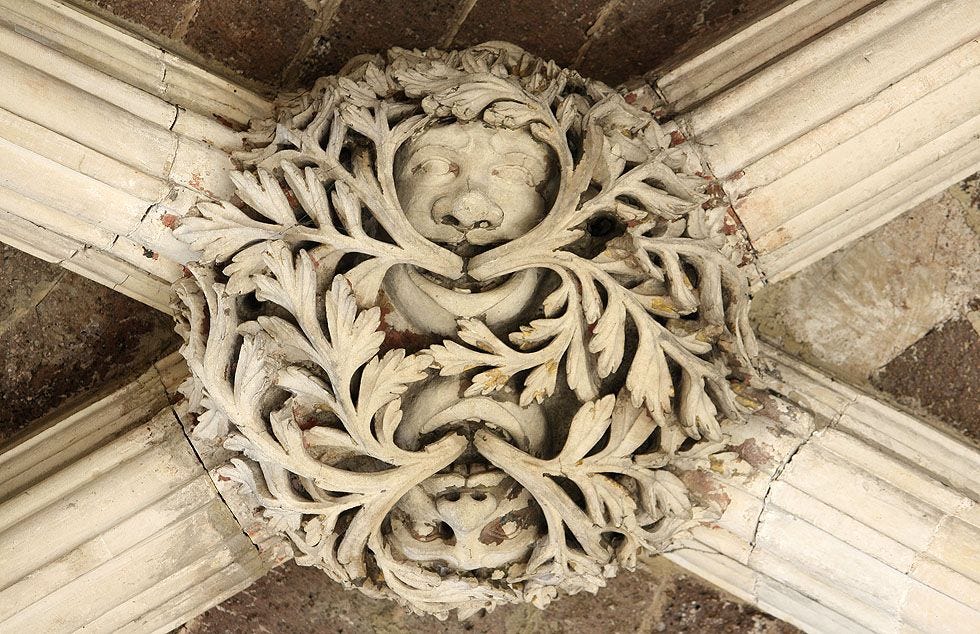
There is also the grumpy looking man in the cloak. One hypothesis is that this is William of Volpiano, a man born on the Isola San Giulio in 962 and who went on to found many monasteries all over the region and across France. He was a sort of medieval Incredible Hulk of monastery foundation, so for a church on the island he came from, dedicated to a saint (Giulio) who also spent his life trying to embed Christianity in that same landscape, William of Volpiano would make a lot of sense. The sword/staff is interesting though. William was never a soldier. That is perhaps why some people prefer to see a staff.
Personally, though, I think Onorato, Bishop of Navaro, is a much better candidate. He was bishop of the area in the early 6th century, so roughly when the church that the 12th-century chuch replaced was originally built. He first built a castle on the island to defend the local community and is said to have founded a church on the island, dedicated to the apostles, on the site of a pagan temple. He also oversaw the church on the island being dedicated as a basilica, rather than just an ordinary church. So, laying out my case:
Onorato was involved in military activity like castle building, as well as church work, hence, perhaps, the sword;
if this pulpit was part of the project to replace the original church on the island, it would make sense for its imagery to be a reminder of that church;
the artistic themes of the pulpit fit with celebrating a man who put a church on a pagan temple and dedicated his church to the people who first spread the word of Jesus (i.e. the apostles). Apostles and Evangelists are not the same but they are both associated with ‘spreading the good word’ (indeed, ‘Evangelist’ comes from the Greek for ‘one who announces something good’) and possibly, by the 12th century, the carvers decided it might be easier and more fun to carve 4 Evangelists, who could be represented as different animals, than 12 apostles, who would all need to be depicted as people.
Anyway, that is my case for the guy in the cloak. After that, we get more certain. The four Evangelists, or the wirters of the 4 gospels, which are the books in the Bible that tell the story of Jesus’s life and teachings, had been depicted for centuries as 4 symbolc shapes, often called, singly or collectively, ‘Tetramorphs’ or ‘a Tetramorph’, meaning ‘four shapes’. The lion, the ox, the eagle and the man (usually with wings, though he is not an angel) always hold a book and are often all depicted together (except when one of them is the patron saint of somewhere. The lion, meaning St Mark, for example, is everywhere in Venice, while Mattew, Luke and John barely get a look in.)
Then there are the other shapes, which make me most convinced that the man in the middle of it all is Onorato. They are all connected with good overcoming evil and with the danger and wildness of non-Christian, especially rural, ‘pagan’ beliefs, just like Onorato building a church over a pagan shrine on an island in a rural area in the 6th century. The crocodile was long associated with evil while the griffin could symbolise heroism and goodness (on account of being a blend of eagle and lion, two animals long associated with bravery and majesty), and on this pulpit, the griffin is definitely winning the fight.
On the back side of the pulpit, the message is similar in theme but very different in execution: a lesson in what might happen to the poor, innocent, gentle soul (the deer) in a world where untamed and unchristian forces (like fierce beasties with sharp pointy teeth and centaurs, which had been associated with lust and violence since classical times) were allowed to run wild.
Sense and sensibilities
There are lots of other things to love on the Isola San Giulio and in the basilica itself. I have never seen anywhere else, for example, a depiction quite like this one, which can be found among the much later wall paintings, probably grom the 16th century:
That isn’t a disembodied head floating on the column. It’s a depiction of an anchoress, or a woman walled into a small room, usually on the side of a church, where she would live the rest of her life, fed by donations of food and often becoming a source of wisdom and advice for those who visited her. Here, we can see the anchoress peering through the decorated hole in her cell wall and, below it, her hand is pictured through another rectangular hole, presumably asking for a donation of food or water. I do not know what is going on with this, since there is no record I can find of the basilica ever actually having an anchoress of its own. Maybe they just really wanted one..?
Nevertheless, for me, the pulpit stole the show. I’ve been thinking about it ever since. Some of this is just personal preference, an individual artistic sensibility, that we all have from our experiences, education and personality. I like simple lines and the slightly surreal way the artist imagined how an ox might actually look holding a book. I also love when an artist gives up a little bit of control to let the viewer bring together symbols and associations for themselves. Later art, especially of the Renaissance, tends to lay out whole narrative sequences, stories from the Bible or the lives of saints illustrated in lavish detail with extra figures and furnishings to explain who did what to whom and what vices or evils it was meant to address.
Earlier medieval art, like the pulpit, often relies on symbols that can be read in different combinations or with various stories in mind. Whichever way you look at it, the pulpit in San Giulio is about Christianity being better than paganism and the gospels being important (which makes sense for a pulpit and lectern) but exactly who you think the figure in the cloak is and precisely what Big Bad Uglies the centaur, the crocodile and the sharp-toothed beasties represent is much more open.
This is not just a function of time, though. Artists have also always made choices. Some earlier medieval art, like the Bayeux Tapestry, which I’ve talked about here, is very narrative. Meanwhile, yesterday in Florence, I had another chance to see Michaelangelo’s ‘David’. It took my breath away again how he packed the human and theological complexities of the story of David and Goliath into such a simple, stripped back piece, from the confident, thoughtful stare of the young man, certain of his victory, to the slightly shy way he hides the stone in his hand, cupped against his thigh, as if just a little worried that he might give the game away or that such a little stone might not be enough after all: as if faith and the doubt coexist in a single moment. Most viewers in 16th-century Florence would have understood David as a prototype for Jesus, since that had been well-established in Christian writing over the centuries, so David’s ambivalence would also have caused many of them to think of Jesus’s moment of doubt on the cross. Simple symbols could invite complex, intersecting ideas, especially in a culture soaked with images and image making.
What kind of art you like best is an entirely personal choice. Lots of people entering the Basilica of San Giulio are drawn to the wall paintings or sometimes to the more purely decorative craftsmanship that went into carved and painted elements all over the interior (but which also represented dedication to faith and, often, the celebration of the beauty of nature as a manifestion of divine creation). And buildings that can offer up such a wide array of choices to anybody who enters them are preciuos and wonderful. But if the pulpit appeals to you, too, you’re most welcome: may your Friday be a little more beautiful because of it. And if it still wouldn’t be your favourite, may it at least be easier to read!
And now, for me, it’s time to hit the road again, this time heading for Bolzano to see what I may see and report back to you on.






